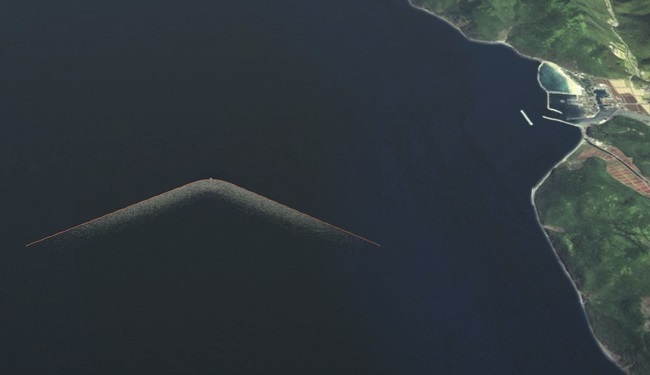
In 2012, 17-year-old Dutch student Boyan Slat devised a passive ocean trash collection device that would collect ocean plastic without harming the marine life. In 2013, he began leading an international team of 100 engineers and scientists to work on a machine that could clean up the ocean without affecting its beauty. By 2014, he raised $2.2 million in crowd funding.
Slat, now the founder and CEO of The Ocean Cleanup, recently announced that the world’s first ocean-cleaning system will be deployed in 2016 near Tsushima, an island between Japan and South Korea. At 1.2-miles, it would be the longest floating structure in world history.
“The array is projected to be deployed in Q2 2016. The feasibility of deployment, off the coast of Tsushima, an island located in the waters between Japan and South-Korea is currently being researched. The system will span 2000 meters, thereby becoming the longest floating structure ever deployed in the ocean (beating the current record of 1000 m held by the Tokyo Mega-Float). It will be operational for at least two years, catching plastic pollution before it reaches the shores of the proposed deployment location of Tsushima Island. Tsushima Island is evaluating whether the plastic can be used as an alternative energy source,” the company said in a statement.
Will the result justify the investment? Using vessels and nets to collect the plastic from one garbage patch would take about 79,000 years and tens of billions of dollars. Besides, such an operation would cause significant harm to sea life and generate huge amounts of CO2 and other emissions. The giant ocean cleanup machine could remove half the plastic from the Great Pacific Garbage Patch in just 10 years, costing 33 times less money.
How is that? Slat’s idea reverses current marine cleanup methods: Instead of sending ships out to chase floating garbage, position a stationary, floating, V-shaped buffer in ocean currents so that water moves through it, funneling plastic debris into a container for capture and removal while allowing animals to swim past the net-free device.
“Taking care of the world’s ocean garbage problem is one of the largest environmental challenges mankind faces today. Not only will this first cleanup array contribute to cleaner waters and coasts, but it simultaneously is an essential step towards our goal of cleaning up the Great Pacific Garbage Patch. This deployment will enable us to study the system’s efficiency and durability over time,” Slat said in a statement.
If the technology works, Ocean Cleanup hopes to build a 62-mile-long system, that would float somewhere between Hawaii and California, big enough to remove 42 percent of millions of tons of plastic in the Pacific Ocean’s trash-laden gyre in less than 10 years.
And why should you care? Some figures are self-explanatory:
- About 8 million tons of plastic enters the ocean each year.
- At least 5.25 trillion pieces of plastic are currently in the oceans.
- Fifty-two million tons of plastic fishing nets are abandoned in the North Pacific Gyre each year.
- Plastic kills over 1 million seabirds and 100,000 marine mammals every year.
- The animals it doesn’t kill are often left deformed.
- Plastic in the oceans costs companies across the world over $13 billion a year and the US government hundreds of millions in coastal cleanup efforts.
Source:







What about the plankton sized plastic particles?
this: .l.
i think they fixed that already
What about plankton? won’t that get caught in the net?
Actually, no. The design idea is that the plastic will be centrifuged out, unless they changed something.
erm,…as usual its america that has created & still is creating the vast plastic landmass in the ocean… maybe we should make them stop it?!?!
No we all are living the problem. Make “I” statements….
So where exactly are we going to put THAT trash? You’re right, we will put it on land. We are making too much garbage that is NOT environment friendly. We will reach a point where there is no where else to put trash…
most plastics they collect can be recycled, the same as they recycle bottles to make new plastic stuf.
http://i57.tinypic.com/1fvjn7.jpg
Didn’t u hear that their aim is to recycle or wnegery
Great Idea!!!
The real problem is indeed the production of to much plastic waste, but if you stopped right now to do that there still would be alot of waste in the ocean. Stopping producing waste is the solution, but this is a real big step for solving all the problems. All the plastic that will be gathered will be ground up to a new plastic granulate that can be used to make plastic products again, the sales of this new granulate will finance the project, and could even make profit.
shoot it into space
There’s a similar problem in space already. Google “space junk”
it ait a problem for the plankton, because they will go true, because why else will they make this, because than they make another big problem for the plankton
How about banning petroleum? It would avoid many problems.
it wont work on manila bay